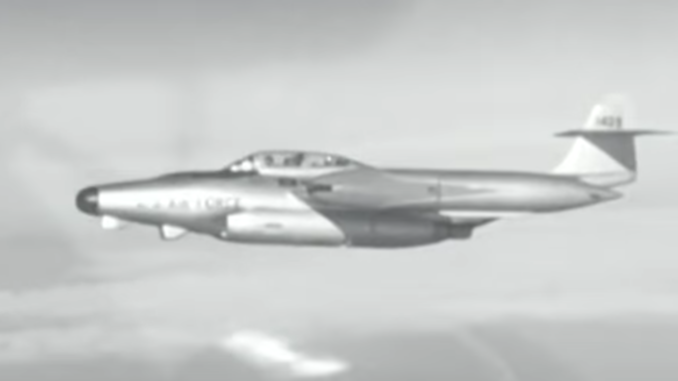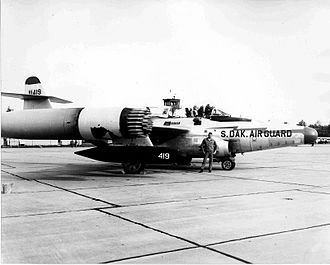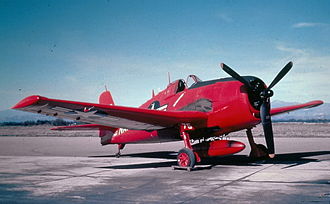
One of the first things taught in any firearms safety course is, “be sure of your target and what’s beyond it”. It’s not enough to just be sure of your target: you must consider the possibility that you could strike something beyond the target, something that you wouldn’t want to destroy. This cardinal rule of weapons safety apparently wasn’t taught in the mid-1950s, at least not to fighter-interceptor pilots.
In the 1950s, the main fighter-interceptor aircraft employed by the US Air Force was the Northrop F-89D Scorpion. The interceptor’s primary mission was to defend the nation against nuclear-armed Soviet strategic bombers, with 30 active-duty USAF squadrons and 7 Air National Guard units spread all around the country equipped with the F-89. The Scorpion was designed immediately after WWII, and was initially meant to be a fighter aircraft armed with both guns and missiles. After the Soviets acquired nuclear capabilities, the Air Force needed a bomber interceptor. The F-89 Scorpion was tapped for this mission, and updated with targeting radar to be used solely with air-to-air unguided missiles. Guided missiles had not yet been developed, so the targeting radar only calculated the optimum time to fire the missiles. The guns and gunsight were removed, as Air Force doctrine stated that missiles were more lethal to bombers than guns, and since the Soviets had no fighters to escort bombers as far as the United States, guns for dogfighting would not be needed.

On August 16, 1956, a need for a dogfighter in southern California suddenly arose. The US Navy, at the time, was developing surface-to-air missiles to defend its ships against attacking aircraft. For this purpose, WWII-vintage fighters were fitted with radio remote-controls and painted bright red for highest visibility, to become unmanned target drones. In this case the drone was a Grumman F6F-5K Hellcat, one of the best fighters of WWII, responsible for downing 5,000 Japanese aircraft late in the war. The drone was supposed to take off from (Naval Air Station) NAS Point Mugu, head out over the Pacific, and be destroyed by a test missile.

Shortly after take off, however, something went wrong. The drone stopped responding to radio commands from the ground and headed southeast towards Los Angeles. The Navy didn’t have any aircraft at NAS Point Mugu that were capable of shooting down the drone, so naturally they called nearby Oxnard Air Force Base, home of the 437th Fighter-Interceptor Squadron. A pair of armed F-89D Scorpions were immediately scrambled to intercept the wayward drone. Each Scorpion carried 104 unguided missiles in pods mounted at the wingtips, 52 in each pod. These were the 2.75-inch Folding Fin Aerial Rockets (FFAR), also known as the “Mighty Mouse” missile that would later be widely used in Vietnam by the Army in air-to-ground attacks. While the FFARs were great in an air-to-ground role, their air-to-air accuracy and efficacy left alot to be desired.

The interceptors reached the drone before it reached LA, but held their fire as it headed into the heavy populated city. The drone made random turns as it flew along. After passing over LA, it turned towards Santa Paula, where it circled overhead before moving on to Fillmore and Frazier Park, then on to the sparsely populated Antelope Valley. The Air Force pilots at last had their chance to take down the wandering Hellcat. With radar locked on target and fire-control set to automatic, they proceeded to attack… and nothing happened. If nothing else was gained that day, at least they’d discovered a design flaw of some sort in the system.
Now with the automatic fire-control system inoperative, the pursuers switched to manual control. Without the aid of radar targeting and automatic-fire control, and no gunsight to “aim” their unguided missiles, the aircrew’s chance of hitting the drone was greatly diminished. Still, it was imperative to stop the target before it again headed towards heavily-populated LA, where a crash would likely cause death and destruction on the ground.
The Scorpions chased the Hellcat southwest out of Antelope Valley, more or less headed back in the direction of LA. Each interceptor fired 42 rockets at the drone in the vicinity of Castaic; almost all completely missed. A couple lucky missiles grazed the drone but did not explode. Turning south, directly towards LA, the fighters each launched 32 more rockets over Newhall (now part of Santa Clarita), all of which missed completely. As they approached Palmdale, each F-89 fired their remaining 30 rockets, without success. Having achieved victory over the humiliated Scorpions, the Hellcat sputtered out of fuel over Palmdale, and spiraled slowly down to a destructive end several miles east of town.
All but 15 of the 208 rockets fired in total by the F-89s detonated when they hit the ground. Many of them started fires, burning at least 1,000 acres, and requiring 500 firefighters to work for two days to extinguish. One of the fires came within 100 yards of the Bermite Powder Company plant, a manufacturer of explosives. Other missiles set Indian Oil Company sumps alight. A number of rockets landed within Palmdale city limits. One resident described a piece of a rocket smashing through the front window of her home, bouncing off the cieling, and crashing through a wall before landing inside a kitchen cupboard. Other homes suffered damage as well. Another missile exploded in the road directly in front of a car driving down the street, destroying the radiator, a tire, and punching numerous shrapnel holes in the car body. Amazingly, the occupants were unhurt. Two workmen were eating lunch under a tree near their work truck when it was hit and destroyed by a rocket. They also were unhurt. It’s absolutely incredible no one was killed or injured. One might wonder what the property damage payouts from the government amounted to?
The dogfight (and the ensuing mayhem on the ground) between two Air Force fighters and an unmanned Navy drone on August 16, 1956, became known as the Battle of Palmdale.
Question of the Night: What kind of excitement happened in your hometown?
